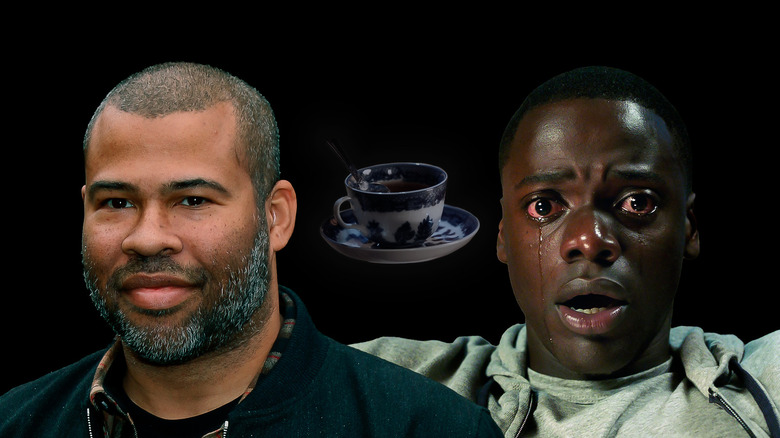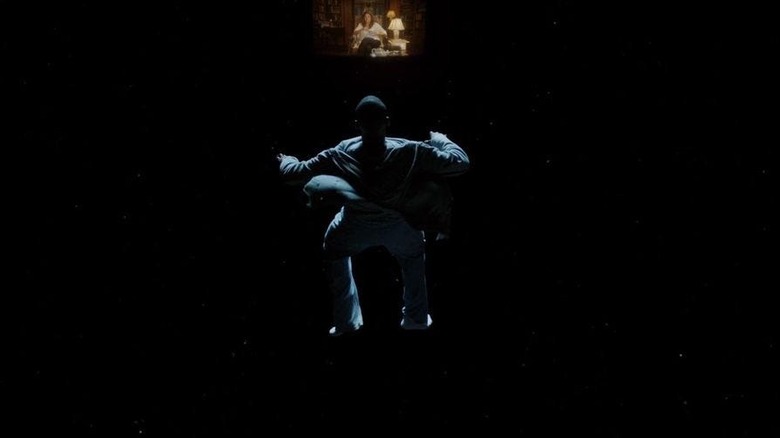Get Out: What Is The Sunken Place & How Does Jordan Peele See It?
In Jordan Peele's groundbreaking directorial debut "Get Out," released back in 2017, Chris (Daniel Kaluuya) heads upstate with his girlfriend Rose (Allison Williams) to spend a quiet weekend with her parents, Dean (Bradley Whitford) and Missy Armitage (Catherine Keener). Late one night, unable to sleep and craving a cigarette, Chris wanders around the house and unexpectedly meets Missy, who's drinking a cup of tea. Before Chris can fully protest, Missy hypnotizes him by convincing him to open up about his mother's death ... and Chris suddenly finds himself paralyzed. With one clink of her spoon and her teacup, Missy tells Chris, "Sink into the floor. Sink." And so, Chris unwillingly does.
Floating in a black void, Chris looks up, terrified, to see what appears to be Missy's face on some sort of large screen as she tells him, "Now you're in the Sunken Place." So what exactly is the Sunken Place? Well, within the narrative of "Get Out," it's a mental fortress where Missy and the Armitage family place the minds of their Black prisoners as they implant the consciousnesses of wealthy white people into their separated bodies. While contained in the Sunken Place, these Black hostages will be able to see through the eyes of their bodies, but they have no control; that control now rests in the hands of the white people who purchased them.
By creating the Sunken Place, Peele crafted one of the most iconic, indelible images in recent cinematic history. So how does the director explain this concept?
Jordan Peele has spoken at length about The Sunken Place
In the aftermath of the original release of "Get Out," it makes sense that Jordan Peele had a lot to say about the specific narrative device known as the Sunken Place. In March 2017, the director posted on X (formerly known as Twitter) about the real meaning of the Sunken Place as it pertains to Black lives, writing, "The Sunken Place means we're marginalized. No matter how hard we scream, the system silences us."
Elsewhere, in a roundtable discussion with directors like Greta Gerwig and Darren Aronofsky held by the Los Angeles Times, Peele said that the Sunken Place also represented two very specific things: the prison-industrial complex in the United States and the role of Black people in movies, horror and otherwise. "There's lots of different sunken places," Peele said. "But this one specifically became a metaphor for the prison-industrial complex, the lack of representation of black people in film, in genre. The reason Chris in the film is falling into this place, being forced to watch this screen, that no matter how hard he screams at the screen he can't get agency across. He's not represented."
Peele noted that he believes Black moviegoers do attend horror movies only to see an all-too-familiar trope where characters of color die first and leave white characters to conclude the story: "So the movie for me became almost about representation within the genre, within itself, in a weird way."
The Sunken Place cemented Get Out as a modern classic – and inspired everything from memes to academic studies
There's no question that "Get Out" as a whole has left a seriously impressive lasting legacy on movies and culture, and the Sunken Place is definitely a huge part of that. In March 2018, The Guardian wrote an extensive piece about the Sunken Place's influence on culture. Not only did the concept spawn a ton of memes, but the piece notes that it simply became a part of the pop culture lexicon.
Kim Kardashian, who was married to Kanye West at the time, shot back at critics asking if the rapper was in the "Sunken Place." Issa Rae's hit HBO comedy "Insecure" referenced the void in an episode. Jordan Peele himself joined in the fun, joking on X about Meghan Markle visiting Buckingham Palace: "A lot of tea cups lying around Buckingham." Beyond that, though, professors like UCLA's Tananarive Due took notice of the Sunken Place's importance, and she crafted an entire course around it titled "The Sunken Place: Racism, Survival and the Black Horror Aesthetic."
"I realised that Get Out was worthy of academic discourse immediately upon seeing the film," Due told The Guardian. "I modelled an entire black horror course around it. When Daniel Kaluuya is floating in that void, it speaks allegorically to so many issues blacks in the United States in particular have grappled with: assimilation, incarceration, slavery and silencing. This visualisation of black pain and struggle has a profound impact on viewers and my students, who readily recognise how Peele's film unpacks so many aspects of their experiences."
From being studied by academia to being mentioned by a Kardashian, few contemporary horror flicks have captured the public's imagination, like "Get Out" and its haunting Sunken Place.

